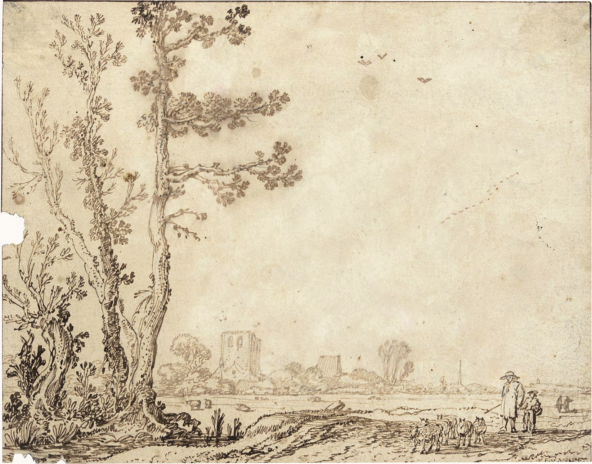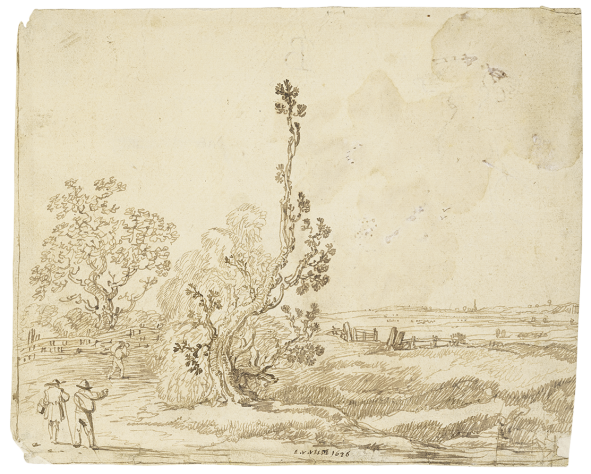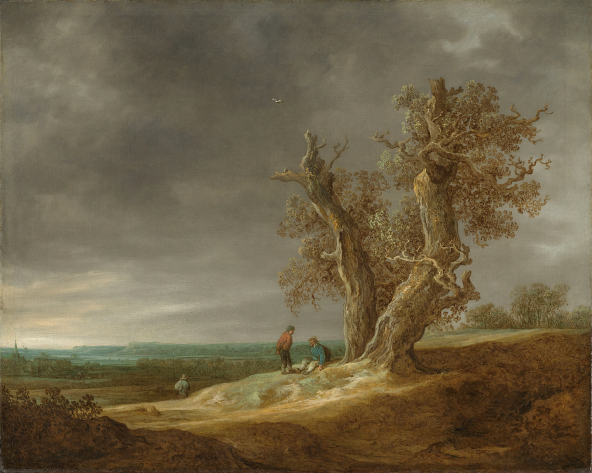Choose a background colour
Esaias van de Velde, Dutch, 1587-1630: A Cluster of Trees near a Ruin, c. 1620-25
Pen and two shades of brown ink over traces of black chalk on paper; framing lines in brown ink.
5 7⁄8 × 7 7⁄8 in. (15 × 20 cm)
Recto, lower center (on the rock), in pen, signed by the artist in pen, EV.VELDE.; verso lower left, in pencil, Es.v.d.Velde; and lower right, C.329.
- Chain Lines:
- Vertical, 24 – 26 mm.
- Watermark:
- Fragment of a Strasbourg Lily (lower half), with figure 4 and letters WR on pendant.
- Provenance:
Sale, Frederik Muller et Cie, Amsterdam, 22 June 1910, lot 410; sale, R. W. P. de Vries, Amsterdam, 14 December 1911, lot 1499; dealer, R. W. P. de Vries, Amsterdam, 1924 (cat. no. 562); I. Q. van Regteren Altena, 1899 – 1980, Amsterdam (Lugt 4617, mark on verso); his sale, Part IV, Christie’s, Amsterdam, 13 May 2015, lot 200; Sheldon and Leena Peck, Boston (Lugt 3847), gift to the Ackland Art Museum, inv. no. 2017.1.86.
- Literature/Exhibitions:
The Hague 1952, no. 63; Keyes 1984, 257 – 58, no. D137, pl. 92.
- Ackland Catalogue:
- 2017.1.86
This study of trees displays Esaias van de Velde’s distinct approach to landscape, offering a compelling sense of the innate character of old, windblown trees, as well as suggesting a remarkable amount of space within a small-scale image. He built strikingly clear zones between foreground and background by employing various tones and weights of line in his handling of the pen. The darker, more saturated brown ink used for the main tree group is also employed in the lines of the ruins to the right to create a sense of a middle ground, while the lighter and softer lines that suffuse the background naturally lend the scene atmospheric perspective.
Some of Esaias’s other drawings appear to relate to the Peck sheet in terms of subject matter, composition, and scale. One was previously unknown when it emerged on the art market in 2005 Fig. 11.1.1

Esaias van de Velde, Landscape with High Trees and a Herder. Pen and ink on paper, 152 × 194 mm. Present whereabouts unknown.
Sotheby’s
The tree group in this case has been pushed to the left, and various ruins and buildings appear in the far background, seen across a wide flat polder. Another drawing, this one signed and dated 1626, retains the centrally placed tree group Fig. 11.2.2

Esaias van de Velde (attributed to), Landscape with Trees and Fields, 1626. Pen and ink on paper, 158 × 192 mm. London, British Museum, inv. no. 1946,0713.1076.6.
The Trustees of the British Museum
As George Keyes pointed out, the date does not appear to be autograph, but there is no reason to doubt the year as accurate.3
The slightly weaker handling of the foliage in this drawing, however, and the tightly crabbed strokes in the ground elements actually suggest another hand. It might instead be the work of Van de Velde’s well-known student, Jan van Goyen (1596 – 1656), who made a number of comparable pen and ink drawings early in his career, most datable to the 1620s, that clearly display the enduring influence of his teacher.4
This drawing appears in a sketchbook in the British Museum, in which almost all of the other 182 leaves belong to Van Goyen.5
He perhaps made a copy of a now lost Van de Velde drawing and added the signature and date himself. A date in the early to mid-1620s also makes sense for the Peck drawing along with the one that emerged in 2005 given their related scale and style. These are among the few pen and ink drawings that Van de Velde executed in the 1620s, a decade in which he otherwise predominately drew in black chalk.6
Some years later, Van Goyen monumentalized this subject matter in his iconic painting Landscape with Two Oaks Fig. 11.3, demonstrating Van de Velde’s continued impact on his former student’s exploration of the aged and twisted tree group motif.7

Jan van Goyen, Landscape with Two Oaks, 1641. Oil on canvas, 88.5 × 110.5 cm. Amsterdam, Rijksmuseum, inv. no. sk-a-123.
Rijksmuseum, Amsterdam
End Notes
Sotheby’s, London, 6 July 2005, lot 153.
Keyes 1984, 267 – 68, no. D169.
Idem.
See Beck 1972 – 91, vol. 1, 6 – 17, nos. 1 – 45a, vol. 3, 28 – 33, nos. 1a – 44.
London, British Museum, inv. no. 1946,0713.1076; and Beck 1972 – 91, vol. 1, 257 – 64, no. 844. Beck dated the album circa 1627 – 35, and considered four of the 182 drawings as by anonymous artists, and the rest by Van Goyen except the one thought to be by Esaias van de Velde. Christiaan P. van Eeghen restored those four to Van Goyen, and considered most of the rest of drawings to have been made circa 1626 – 27; see Van Eeghen 1997.
For Van de Velde’s switch to the medium of black chalk, see Keyes 1987. Keyes dated the present sheet to circa 1620 based on comparison with Van de Velde’s drawing dated that year, also in the Peck Collection (Ackland Art Museum, inv. no. 2017.1.87); see Keyes 1984, 243, no. D94, and 257 – 58, no. D137.
For the painting, see especially C. J. de Bruyn Kops in Amsterdam, Boston & Philadelphia 1987 – 88, 326 – 28, no. 36.
